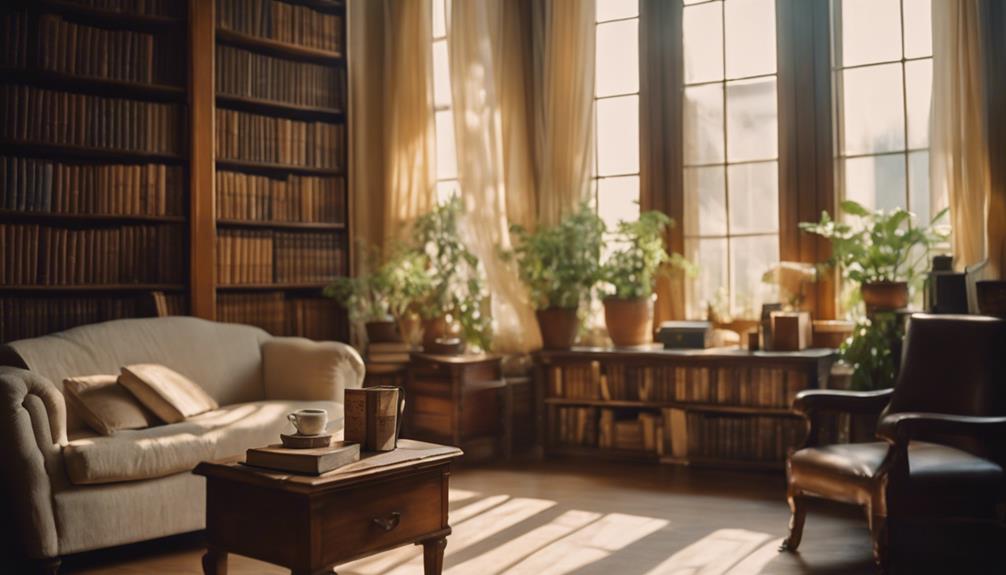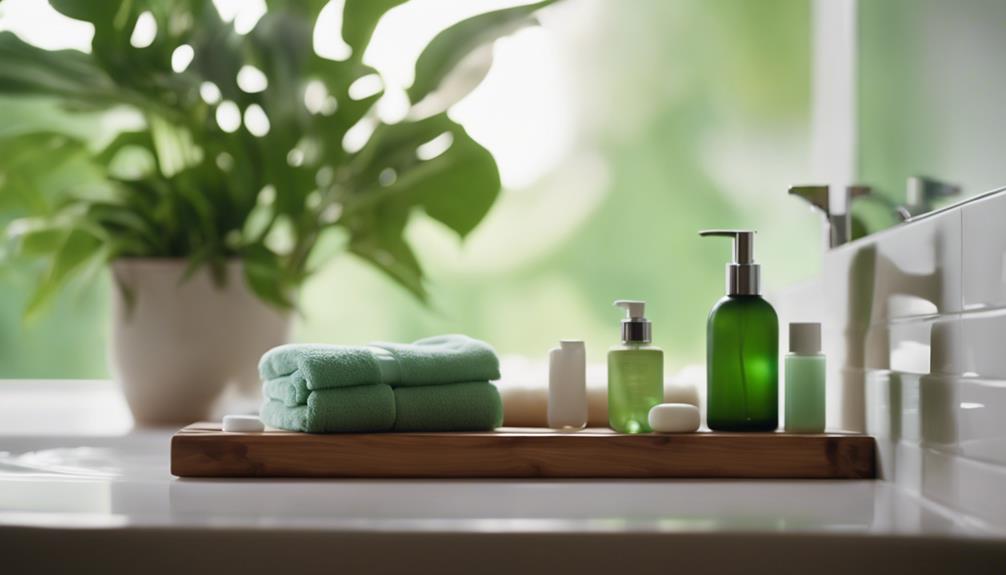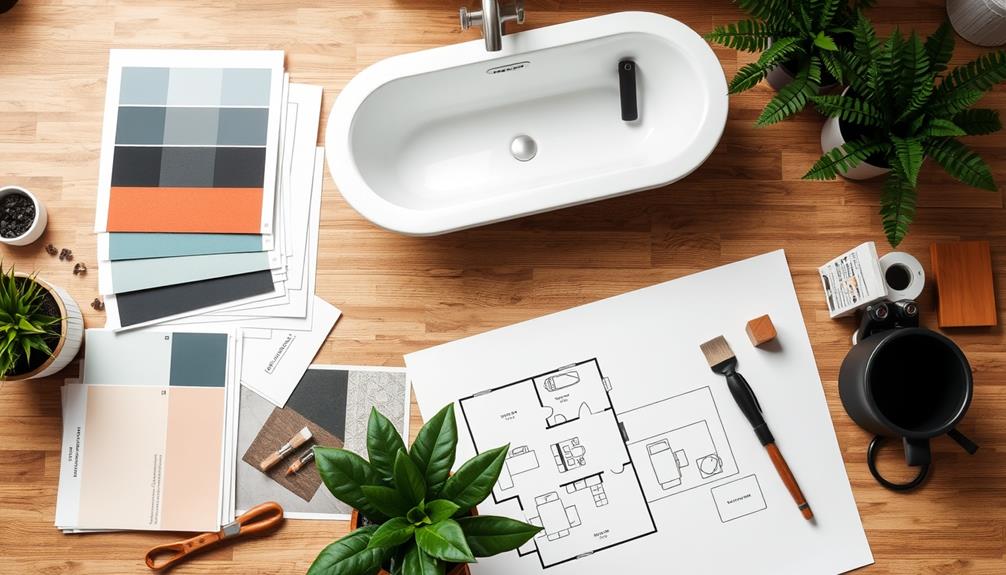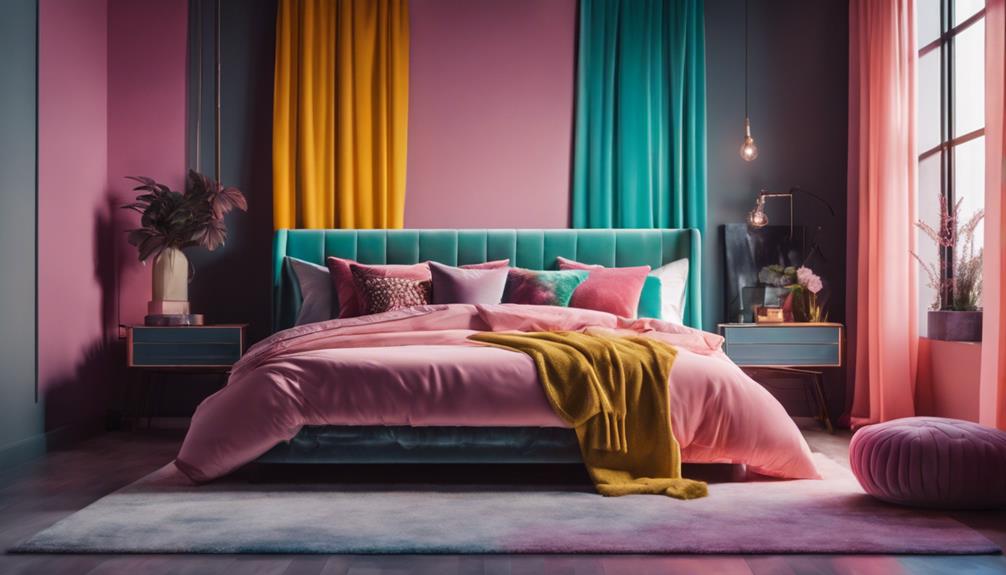To achieve an impressive Light Academia room decor, focus on soft, muted tones such as cream, beige, and pastels. Incorporate natural materials like wood and cotton to add warmth and texture. Integrate vintage elements like an ornate writing desk or a brass floor lamp for a scholarly atmosphere. Enhance your walls with botanical prints and display antique bookends for motivation. Don’t forget to include soft string lights for a whimsical touch. This inviting aesthetic not only boosts creativity but also promotes tranquility, creating a perfect escape. Interested in more ideas? There’s plenty more to discover!
Key Elements
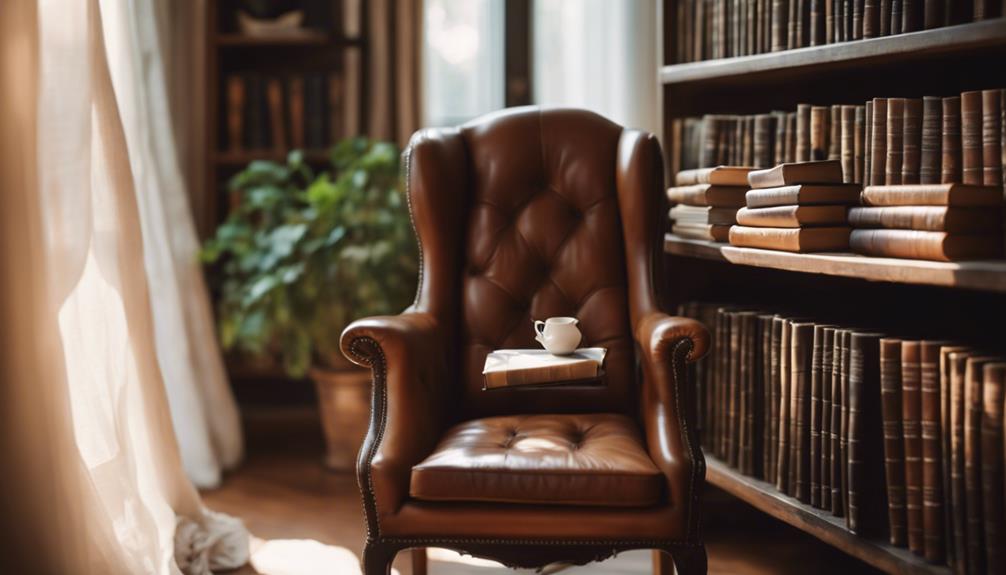
When you create a Light Academia space, the color scheme, materials, and textures play essential roles in setting the tone.
Soft, muted colors paired with natural materials like wood and linen help you achieve that serene, scholarly vibe.
Textures, from cozy knits to aged leather, add depth and warmth, making your room an inviting retreat for study and reflection.
Color Scheme
The Light Academia color scheme offers a serene palette of soft, muted tones like cream, beige, and white, perfect for creating a calming atmosphere in your space.
To enhance this tranquility, consider incorporating accent colors like pastels—think powder blue, baby pink, and sage green. These shades add a touch of femininity and warmth, making your room feel inviting.
You can also introduce earthy tones, such as terracotta, to provide rustic charm and balance within the overall color palette. This combination of soft and earthy hues creates a harmonious backdrop for your scholarly activities.
Don't forget to add gold accents! These elegant touches can be found in decorative items and furniture detailing, contributing to a refined look that elevates your decor.
Pair these colors with natural materials like wood and textiles to maintain that cozy, inviting ambiance.
Materials
Natural materials like wood, cotton, and linen bring a light and airy feel to Light Academia decor, enhancing its serene and inviting atmosphere. When you incorporate these elements, you're setting the perfect foundation for a scholarly aesthetic.
Vintage items, such as antique books, globes, and hourglasses, serve as essential accents that amplify the intellectual vibe. They not only add character but also tell a story, making your space feel personal and curated.
Soft muted colors are key in this style, focusing on neutral tones like creams, beiges, and light pastels. These colors create a calming ambiance, while occasional gold accents can elevate the sophistication of your decor.
You can also play with layering textures to add depth and interest. Combining fabrics like lace, ruffles, and woven cotton creates a cozy space that invites relaxation and contemplation.
Textures
Incorporating a variety of textures is essential to creating the layered, inviting atmosphere characteristic of Light Academia decor.
Start with light, airy materials like cotton and linen for your drapes and bedding. These fabrics not only enhance the ethereal quality of your space but also create a fresh and inviting vibe. You'll want to mix in elements like lace or sheer fabrics, which add a delicate touch that complements vintage floral prints beautifully.
To ground your aesthetic, opt for natural textures such as wooden furniture and ceramic vases. These pieces promote a connection to nature and add warmth. You can further enhance your decor with iconic patterns like plaids, gingham, and dainty florals, which bring sophistication and depth to your room.
Don't forget to layer in soft throws and ruffled bedding to create a cozy environment. Vintage-inspired knick-knacks can also contribute visual interest.
Essential Fixtures and Furniture
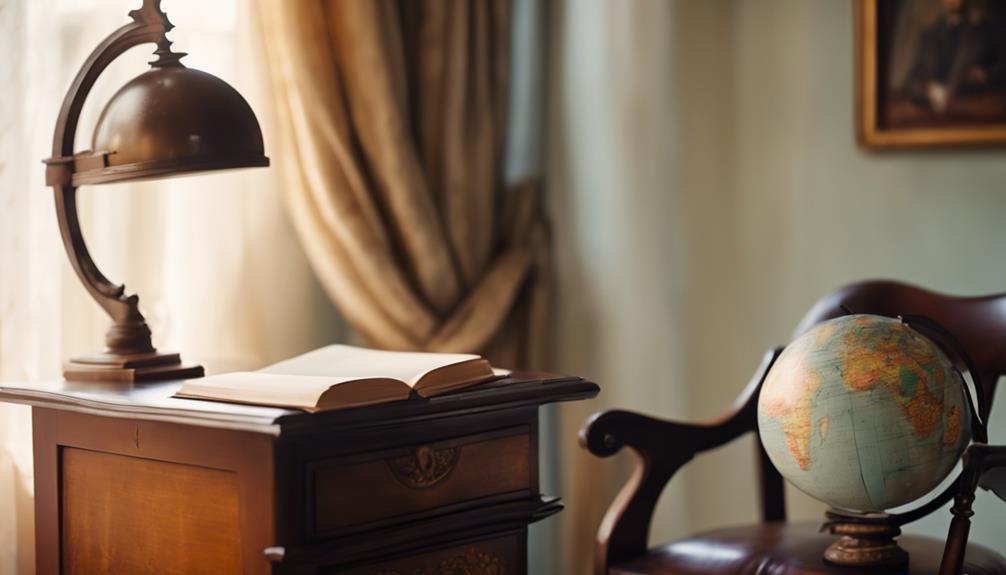
When it comes to Light Academia decor, choosing the right fixtures and furniture is essential.
A vintage wooden writing desk adds charm and functionality, while an antique brass floor lamp provides the warm lighting you need for late-night reading.
Don't forget to include a vintage globe bar cart for a touch of elegance and practicality in your scholarly space.
Vintage Wooden Writing Desk
A vintage wooden writing desk acts as a charming centerpiece in your Light Academia decor, combining functionality with timeless elegance. Typically crafted from durable materials like oak or walnut, these desks not only serve as practical workspaces but also enhance the overall aesthetic of your room. Look for designs that feature ornate details, such as carved legs and gilded accents, which reflect the sophistication of Victorian and Baroque styles.
Incorporating a vintage wooden writing desk into your decor helps create a scholarly atmosphere, perfect for study and creativity. Many of these desks come with multiple drawers, providing an efficient solution for organizing stationery and academic tools, ensuring your workspace remains clutter-free.
To complement the Light Academia style, choose a desk that fits within your color palette of soft neutrals and pastels, harmonizing beautifully with botanical prints and antique items around the room.
Antique Brass Floor Lamp
Why not elevate your Light Academia decor with an antique brass floor lamp that not only illuminates your space but also adds a timeless elegance? This striking piece serves as a focal point, infusing your room with vintage elegance while providing the warm, ambient lighting essential for reading and study.
The rich, golden hue of the brass beautifully complements the light, neutral color palette typical of the Light Academia aesthetic, enhancing the sophisticated and scholarly atmosphere you desire.
Many antique brass floor lamps feature intricate detailing, like ornate bases and adjustable shades, allowing you to customize the lighting angle to suit your needs. This functionality not only adds to their aesthetic appeal but also guarantees you can create the perfect environment for both relaxation and focus.
Incorporating an antique brass floor lamp evokes a sense of nostalgia and romance, reminiscent of classic libraries and study rooms from centuries past. These lamps pair wonderfully with other antique furnishings, creating a cohesive look that celebrates the beauty of vintage craftsmanship within your Light Academia decor.
Vintage Globe Bar Cart
Elevate your Light Academia aesthetic with a vintage globe bar cart, a perfect blend of functionality and charm that sparks both conversation and inspiration. This piece embodies the essence of travel and scholarly pursuits, making it a stunning focal point in your room. Crafted with an antique finish, it exudes sophistication and invites curiosity about the world.
Imagine stocking the cart with vintage glassware and classic liquors, creating a warm atmosphere for social gatherings. The rotating globe design not only serves as a conversation starter but also reflects your passion for exploration and geography, enhancing the intellectual vibe of your space.
You don't have to break the bank to find one—check thrift stores, estate sales, or antique shops to discover a unique piece that complements your Light Academia decor. Pair the cart with a vintage style vase filled with fresh flowers, and you've got a delightful arrangement that radiates charm.
With a vintage globe bar cart, you'll effortlessly infuse your room with character, functionality, and a timeless appeal that resonates with the Light Academia spirit.
Lighting Ideas
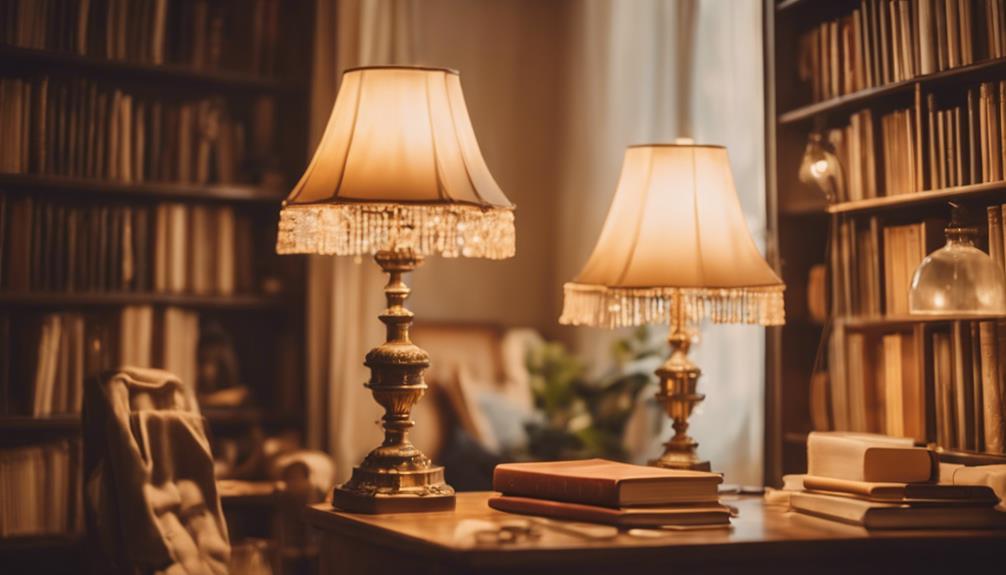
When it comes to lighting, you've got plenty of options to enhance your light academia vibe.
Soft string lights can create a whimsical touch, while a vintage crystal chandelier adds elegance and charm.
Don't forget to incorporate sunlit windows and an antique brass table lamp to guarantee your space feels both bright and inviting.
Soft String Lights Draped
How can you transform your space into a cozy haven with soft string lights draped elegantly along walls and furniture?
Soft string lights are essential for achieving that enchanting light academia aesthetic. By choosing fairy lights in warm white or pastel tones, you maintain a cohesive color palette that enhances the light and neutral shades typical of this style.
Consider incorporating vintage-inspired designs, like glass bulbs or floral motifs, to add an extra layer of charm and elegance to your decor. Drape these lights along bookshelves, windows, or even around potted plants to create a warm and inviting atmosphere.
Layering your string lights, such as wrapping them around the edges of framed art, adds depth and visual interest to your space.
Don't forget the practicality of adjustable ambiance; using dimmable string lights lets you set the perfect mood for studying or cozy evenings spent reading.
With these thoughtful lighting choices, you can easily create a welcoming environment that reflects your scholarly pursuits and personal style. Embrace the magic of soft string lights, and let your room become a tranquil retreat.
Vintage Crystal Chandelier
A vintage crystal chandelier instantly transforms your room into a sophisticated haven, blending elegance with the light academia aesthetic. These stunning fixtures serve as enchanting focal points, evoking a sense of refinement reminiscent of 18th-century interiors.
When you hang a vintage crystal chandelier, its intricate designs, made from a beautiful combination of glass and metal, create a mesmerizing play of light that enhances the cozy ambiance of your scholarly space.
To achieve the perfect atmosphere, opt for warm or yellowish bulbs that make the room inviting, ideal for those long reading sessions or study marathons. Pair your chandelier with soft, neutral color palettes and antique furnishings to further complement the light academia aesthetic. This combination not only adds a touch of opulence but also guarantees your décor feels harmonious and thoughtfully curated.
When choosing a vintage crystal chandelier, consider the size of your room and ceiling height to prevent overwhelming the space. With the right fixture, you'll effortlessly elevate your room's elegance and sophistication, creating a delightful environment that inspires creativity and learning.
Sunlit Window Sill Candles
Adding sunlit window sill candles enhances the enchanting atmosphere created by your vintage crystal chandelier, filling your space with a warm, inviting glow that perfectly aligns with the light academia aesthetic.
These candles reflect natural light, casting a soft, flickering illumination that adds to the serene vibe of your room.
To achieve a cohesive look, choose candles in pastel hues like dusty rose or sage green. These colors complement the airy color palette typical of light academia decor, bringing a sense of tranquility and charm.
Pair your candles with elegant holders—think gilded or vintage-inspired options—to elevate the aesthetic further.
Don't forget to arrange your candles alongside potted plants or dried flowers. This combination harmonizes with natural elements, creating a scholarly atmosphere that invites relaxation and contemplation.
For an added touch, opt for scented candles with uplifting fragrances like vanilla or lavender. They evoke a calming ambiance, perfect for those moments when you settle down with a good book or immerse yourself in study sessions.
Sunlit window sill candles truly transform your space, making it a delightful sanctuary of light academia charm.
Antique Brass Table Lamp
Antique brass table lamps effortlessly enhance the cozy ambiance of your light academia space with their warm glow and vintage charm. Their rich, golden hue beautifully complements the light, neutral color palette typical of these spaces, adding a touch of elegance and sophistication.
You'll find that many antique brass lamps feature intricate designs, like floral patterns or ornate bases, which reflect artistic influences from the Victorian and Baroque periods. Not only do these lamps provide functional lighting, but they also serve as decorative focal points.
Position them on side tables or desks, where they can illuminate your favorite books and vintage accessories, creating an inviting reading nook. The warm light casts a gentle glow, making it perfect for late-night study sessions or leisurely afternoons spent with a good novel.
Incorporating an antique brass table lamp can greatly elevate your room's overall aesthetic. This harmonious blend of vintage style and scholarly ambiance captures the essence of light academia, transforming your space into a cozy haven that inspires creativity and reflection.
Embrace the elegance of antique brass, and watch your light academia room flourish.
Decorative Elements
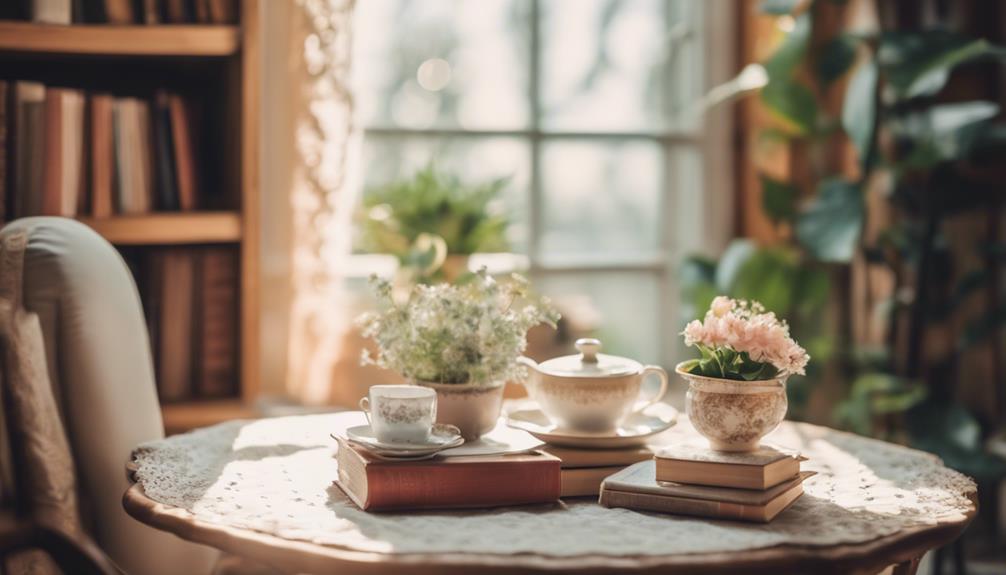
To elevate your Light Academia space, consider incorporating framed botanical prints that add a touch of nature and elegance.
A vintage porcelain tea set not only serves as a charming decorative piece but also invites moments of reflection and conversation.
Antique bookends with floral designs can enhance your scholarly vibe while keeping your collection of books organized and visually appealing.
Framed Botanical Prints
Framed botanical prints bring elegance and a touch of nature into your space, perfectly complementing the Light Academia aesthetic. These prints often showcase delicate illustrations of plants and flowers, evoking a sense of Victorian botanical art that celebrates natural beauty. By using neutral or pastel backgrounds, you can enhance the calming environment that these prints create, allowing for a serene atmosphere in your room.
Arranging framed botanical prints in a gallery wall format not only serves as a stunning focal point but also showcases your personal taste. You can choose vintage or ornate frames to add an antique touch, aligning seamlessly with the Light Academia theme that cherishes history and sophistication. This thoughtful decor choice not only beautifies your space but also promotes relaxation and creativity—two essential aspects of the Light Academia lifestyle.
Incorporate these botanical prints to transform your room into a scholarly haven where you can read, reflect, and create. Embrace the tranquility they offer, and let them inspire your thoughts and artistic endeavors. With framed botanical prints, you'll effortlessly elevate your decor while immersing yourself in the beauty of nature.
Vintage Porcelain Tea Set
A vintage porcelain tea set instantly elevates your decor, bringing both elegance and a sense of history to your light academia-inspired space. These beautiful tea sets often feature delicate floral patterns and intricate designs, serving as both functional items and decorative accents. You can easily find unique vintage porcelain tea sets at antique shops or thrift stores, each piece telling its own story and adding character to your decor.
Incorporating a vintage tea set into your home creates a warm, inviting atmosphere, perfect for hosting gatherings or enjoying quiet moments with a good book. Display it on a wooden shelf or as part of a curated coffee table arrangement to add a scholarly touch, showcasing your appreciation for traditional craftsmanship and timeless beauty.
Not only do these tea sets enhance your decor, but they also act as conversation starters. They reflect a love for history and culture while aligning perfectly with the romanticized aesthetic of light academia.
Antique Bookends With Floral Design
Antique bookends with floral designs not only keep your books organized but also infuse your space with vintage charm and elegance. These decorative elements enhance the light academia aesthetic by adding character and sophistication to your bookshelves or desk.
Crafted from materials like brass, wood, or ceramic, you'll find intricate patterns that reflect the grandeur of Victorian or Baroque styles.
Incorporating these floral bookends into your decor allows you to play with neutral color palettes like cream or beige, creating a cohesive look that complements the overall theme. The botanical motifs in the designs also strengthen the aesthetic's connection to nature, promoting a serene atmosphere perfect for studying or relaxing.
When you display antique bookends alongside vintage books and other academic decor, you transform your space into a curated and inviting reading nook. This combination not only organizes your collection but also serves as a beautiful focal point, making your study area feel more inspiring and personalized.
Flooring
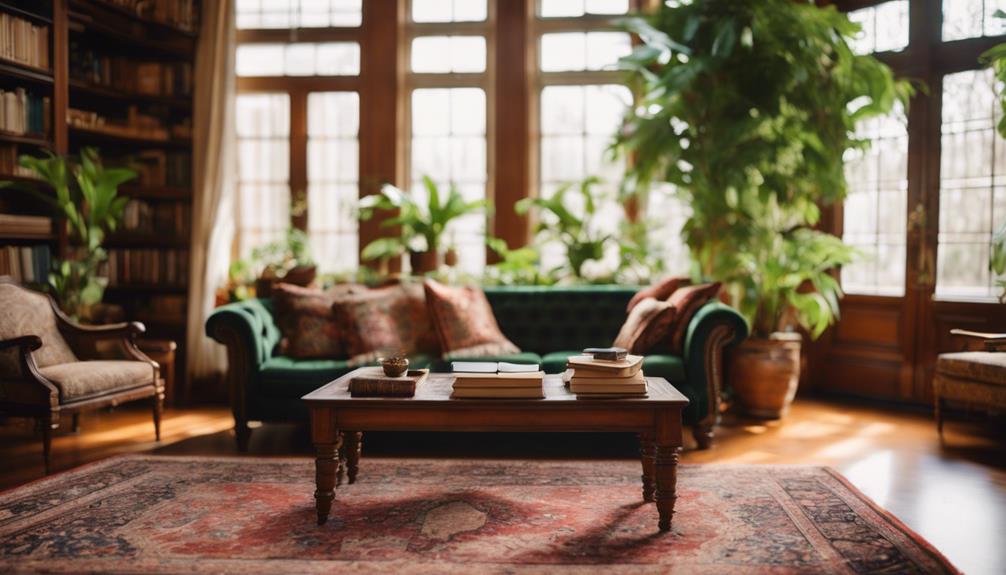
When it comes to flooring in your light academia space, you can't go wrong with light oak hardwood or distressed whitewashed wood planks for that warm, inviting feel.
Creamy beige carpet tiles can add a soft touch, enhancing both comfort and the overall aesthetic.
Each option not only contributes to the vintage charm but also reflects the brightness that defines this style.
Light Oak Hardwood Flooring
Light oak hardwood flooring enhances the airy vibe of Light Academia, creating a warm and inviting space that feels both elegant and welcoming. This flooring features a light, neutral tone that perfectly complements the airy and calming aesthetic you're aiming for. Its ability to reflect natural light not only brightens your rooms but also contributes to the cheerful ambiance characteristic of Light Academia.
Durable and easy to maintain, light oak hardwood flooring is practical for high-traffic areas while elevating the overall decor. The natural grain patterns add texture, harmonizing beautifully with vintage and rustic elements commonly found in this style. You'll appreciate how these details create a cohesive look that feels both sophisticated and lived-in.
If sustainability is important to you, you'll be pleased to know that eco-friendly options for light oak hardwood flooring are available. This way, you can enjoy a stunning aesthetic without compromising your values.
Distressed Whitewashed Wood Planks
Distressed whitewashed wood planks instantly transform any space into a soft, inviting haven that perfectly aligns with the light academia aesthetic. Their light color reflects natural light, enhancing the room's brightness and creating a cozy feel.
These planks are designed to complement neutral tones, making them versatile for various decor styles, including Cottagecore and Rustic designs. The vintage charm of distressed whitewashed wood planks pairs beautifully with light, airy textiles and antique furniture, adding character and depth to your home.
The distressed finish not only provides a lived-in look but also invites relaxation and encourages learning, making your space feel welcoming and scholarly. You'll appreciate how easy they're to maintain, as the light color helps mask minor scuffs, ensuring your floors remain timeless and elegant.
With distressed whitewashed wood planks, you can create the perfect backdrop for your light academia decor, allowing your books and art pieces to shine against a beautifully crafted flooring choice. Embrace this flooring option to elevate your space while embodying the essence of the light academia aesthetic.
Creamy Beige Carpet Tiles
Creamy beige carpet tiles lay a warm and inviting foundation for your Light Academia room, enhancing its cozy atmosphere with their neutral tones. The soft texture of these tiles not only adds comfort but also provides sound insulation, making them perfect for a serene study or reading nook.
With their light color, creamy beige carpet tiles reflect natural light, contributing to a bright and airy ambiance that's essential for achieving that scholarly aesthetic. You'll find that these tiles complement vintage furniture beautifully, reinforcing the romanticized vibe you're aiming for in your space. Their versatility allows you to play with various patterns and styles, ensuring that your flooring aligns perfectly with your decor.
Installation and maintenance are a breeze, giving you the flexibility to replace individual tiles if they ever become worn or stained. This practicality means you can focus more on creating your dream Light Academia environment without worrying about long-term upkeep.
Embrace the cozy atmosphere and timeless elegance that creamy beige carpet tiles bring to your room, and watch as they transform your space into a haven of inspiration and creativity.
Can Dark Academia Fashion Influence My Light Academia Room Decor?
Incorporating elements of dark academia fashion aesthetic scholar into your light academia room decor can add a touch of sophistication and vintage charm. Think rich, warm hues, vintage-inspired furniture, and scholarly accents like old books and antique art pieces to create the perfect blend of both aesthetics in your space.
Conclusion
Incorporating light academia decor into your space can transform it into a bright and inspiring haven.
By focusing on key elements, choosing the right fixtures, and adding thoughtful decorative touches, you'll create an atmosphere that encourages creativity and scholarly pursuits.
Don't forget about lighting to enhance the aesthetic and flooring to tie everything together.
With these ideas, you'll wow everyone who steps into your room, making it a true reflection of your unique style!
